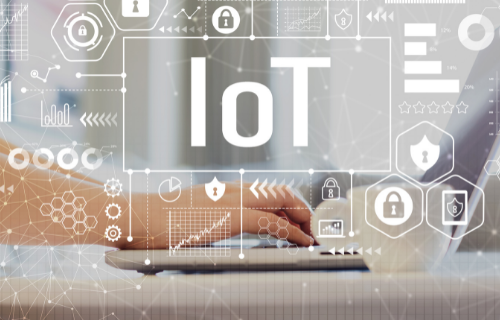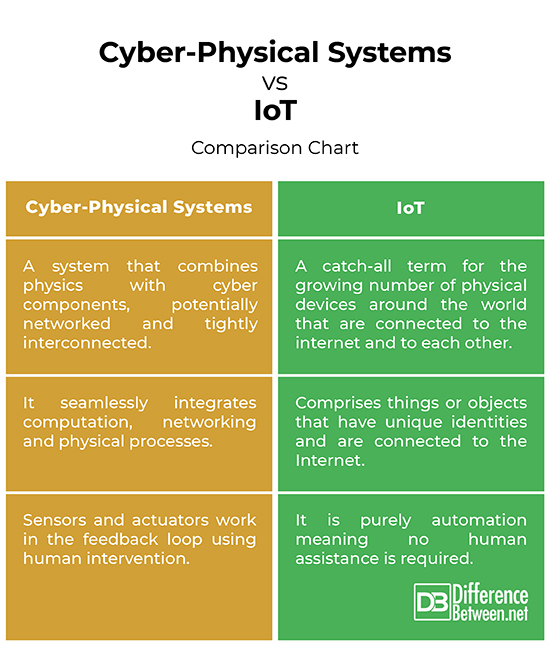Difference Between Cyber-Physical Systems and IoT
The Internet started as a simple connection between two computers, but the real revolution happened when computers from any corner of the world were started connecting seamlessly, which led to the development of a large number of services on top of this worldwide network. Cyber-physical systems and Internet of Things are two such revolutions that are shaping the future of technology, and eventually the future of the world.

Cyber-Physical Systems
Cyber-physical systems (CPS) are intelligent engineered systems that are built from the seamless integration of computation, networking, and physical processes. CPS consists of a collection of computing devices that communicate with each other and interact with the physical world via sensors and actuators in a feedback loop. Cyber-physical Systems are a collection of physical and computer components connected together in a network. Often called a Next Generation Computing System, CPS are technical systems that are controlled by computer based algorithms.
Some of the most exciting and advanced innovations today are cyber-physical Systems. Examples include autonomous cars, quad-copters, smart grid, robotic systems, industrial control systems, smart lighting systems, and more. The idea behind CPS is to develop systems that integrate the dynamics of the physical processes with those of the software and networking. Increasingly such systems are everywhere, from smart buildings to medical devices to vehicles, and what not. So, CPS is a system that combines physics with cyber components, potentially networked and tightly interconnected.

Internet of Things (IoT)
Internet of Things, or simply called IoT, is of the fundamental pillars of the fourth industrial revolution. With the increase in adoption of more advanced technologies such as machine learning, augmented reality (AR), cyber-physical systems, and IoT, the world of digital transformation has taken a huge leap. So, IoT is a networked world of interconnected devices, objects, and people. IoT is a catch-all term for the growing number of physical devices around the world that are connected by a common thread called the Internet.
However, IoT is not just limited to connecting things to the Internet; it allows these things to communicate and exchange data while executing meaningful applications towards a common goal. As related devices connect with each other, they can become an intelligent system of devices and when these devices share data over the cloud and analyze the data, it can be translated to meaningful information which can transform the businesses and our lives in countless ways.
Difference between Cyber-Physical Systems and IoT
Technology
– Cyber-physical systems (CPS) are intelligent engineered systems that seamlessly integrate computation, networking and physical processes. It is a system that combines physics with cyber components, potentially networked and tightly interconnected, providing the foundation for IoT. Internet of Thins (IoT) is a catch-all term for the growing number of physical devices around the world that are connected to the internet and eventually to each other. IoT is a networked world of interconnected devices, objects, and people.
Focus
– The concept of cyber-physical systems is a generalization of embedded systems. These systems are concerned with how physical systems can be controlled and monitored using the cyber space. In practical terms, this integration takes into account both the cyber part and the physical part working together. IoT, on the other hand, represents a more evolved state where physical and digital worlds are blended into a single space. It is focused on how these physical objects can be connected to the internet to do something meaningful.
Mechanism
– Cyber-physical systems are smart embedded systems that integrate sensor networks with embedded computing to monitor the physical environment. The mechanism is controlled and monitored by computer-based algorithms. With human assistance, these systems can autonomously evaluate operational conditions and subsequently support decision-making. IoT, on the other hand, is purely automation meaning no human intervention is required.
Scope
– The IoT is the on the level of physical objects and it is concerned with building ubiquitous connection in the physical space. The scope of IoT is not limited to just connecting things; it allows these things to communicate and exchange data, which can be analyzed and processes further into meaningful information. Cyber-physical systems integrate actuators or sensors with networking technologies. Sensors and actuators work in the feedback loop using human intervention so that their behavior could be changed based on user’s requirements.
Cyber-Physical Systems vs. IoT: Comparison Chart

Summary
IoT is an arrangement of connection and communication among computing devices or objects or people which are provided with the capability to exchange and transmit data over a communication network without human intervention. IoT can be implemented in almost every domain area that requires things to interact with over the internet to execute tasks intelligently without human intervention. Cyber-physical systems are the integration of computation, networking, and physical processes. These are intelligent systems that link cyberspace with the physical space via a network of computational elements, such as actuators and sensors.
What is Cyber-Physical Systems in IoT?
Cyber-physical systems provide the foundation for IoT by integrating physics with cyber components, potentially networked and tightly interconnected.
What are examples of Cyber-Physical Systems?
Examples of cyber-physical systems include autonomous cars, quad-copters, smart grid, robotic systems, industrial control systems, smart lighting systems, and more
What is meant by Cyber-Physical Systems?
Cyber-physical systems are a collection of physical objects that are represented in the digital world and integrated with computation, storage, and communication capabilities, being connected to each other in a network.
What is the difference between embedded system and cyber physical system?
Cyber-physical system is about the intersection of physical components with the cyber components, representing the whole system. Embedded systems refer to the brain of the system where the codes are executed.
- Difference Between Caucus and Primary - June 18, 2024
- Difference Between PPO and POS - May 30, 2024
- Difference Between RFID and NFC - May 28, 2024
Search DifferenceBetween.net :
Leave a Response
References :
[0]Rajkumar, Raj, et al. Cyber-Physical Systems. Massachusetts, United States: Addison-Wesley, 2016. Print
[1]Alur, Rajeev. Principles of Cyber-Physical Systems. Massachusetts, United States: MIT Press, 2015. Print
[2]Rea, Pierluigi, et al. Design, Applications, and Maintenance of Cyber-Physical Systems. Pennsylvania, United States: IGI Global, 2021. Print
[3]Greengard, Samuel. The Internet of Things. Massachusetts, United States: MIT Press, 2015. Print
[4]Bali, Vikram, et al. Cyber-Physical, IoT, and Autonomous Systems in Industry 4.0. Florida, United States: CRC Press, 2021. Print
